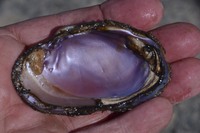Nature Column April 4, 2013
Mussels
You know that steelhead fishing is slow when the conversations between bank and boat fishermen revolve around how many non-target fish, such as suckers and salmon smolts, they’ve caught. It got especially interesting when a fisherman up stream of me laughed and yelled, “Hey, I caught a clam!” I looked at the shell of a Western pearlshell mussel at my feet and knew exactly what he had caught.
Mussels are mollusks. They are called bivalves because they have two mirror-image external shells that are hinged at the back at what is called the beak. Shells grow outward from the beak in a concentric pattern. The ridges on the outside are often rough, but the inside of the shell is lined with a smooth mother-of-pearl called the nacre, that was once used to make garment buttons.
The shell at my feet was three inches long and the inside was as purple as some of the crocuses just starting to bloom in my yard. I counted over thirty ridges on the shell. Assuming that these ridges were like tree rings, the mussel was at least thirty years old. That makes it a young pearlshell—they can live to be over 100 years old.
The three native species of mussels in our area should not be confused with the highly invasive and damaging zebra and quagga mussels (they are really clams). Unlike native mussels, these reproduce rapidly and can attach to hard surfaces and devastate ecosystems.
Mussels look like clams and only really differ in the fact that mussels require an intermediate host such as a fish to complete their life cycle where clams do not. The lifecycle begins when the male spews sperm into the water column. Females suck the sperm into their shell to fertilize their eggs. Embryos develop into several thousand larvae called glochidia, which are released by the female. Tiny mussel glochidia attach to passing fish and are transported through the system.
Mussels spend their lives buried in the bottom of streams and rivers where if they are seen at all are mistaken for rocks. And because they are easily ignored, mussels are poorly understood, yet they are one of the most imperiled groups of organisms in North America. Of the nearly 300 species here, 35 species have gone extinct without scientists ever getting a chance to study them.
What we do know is that mussels play a key role in the environment. Mussels are filter feeders, meaning they strain their food from the water, and they can filter a substantial amount of water through the year. Just like a filter on your water tap, they remove tiny suspended material and improve water purity. They are also a staple on the menu for a wide variety of predators including river otters, muskrats, raccoons, fish, and birds such as gulls and herons.
Pearlshells are finicky about their living conditions as well. They thrive in streams and rivers that are cold and pure and decline when nutrient loads, silt, and pollution increase. As long-lived species, that makes them exceptionally good barometers for the overall health of the aquatic ecosystems where they reside.
Pearlshell numbers are declining and that barometer is telling us that our waters may be slowly declining in quality. Ironically, the fewer the pearlshells to filter the water, the faster water quality will degrade and that will bring an entirely new suite of problems. It’s amazing that such a simple creature can be so important to us.
By Terry Thomas
Terry is a wildlife biologist with 26 years experience.

Western Pearlshell mussels are wonderful creatures that play a significant role in purifying our rivers. They are declining though, and that may spell trouble for water quality.